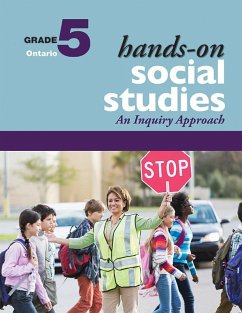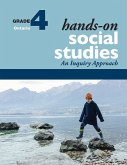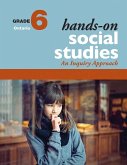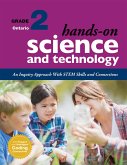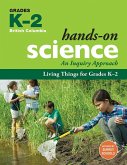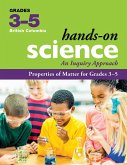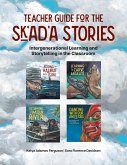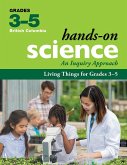- Broschiertes Buch
- Merkliste
- Auf die Merkliste
- Bewerten Bewerten
- Teilen
- Produkt teilen
- Produkterinnerung
- Produkterinnerung
Filled with a year's worth of classroom-tested hands-on, minds-on activities, this resource conveniently includes everything both teachers and students need. The grade 5 book is divided into two units: 1. CanadaFirst Nations and Europeans in New France and Early 2. The Role of Government and Responsible Citizenship STAND-OUT FEATURES * focuses on the goals of the Ontario Social Studies curriculum * adheres to the Growing Success document for assessment, evaluating, and reporting in Ontario schools * builds understanding of Indigenous knowledge and perspectives TIME-SAVING, COST-EFFECTIVE…mehr
Andere Kunden interessierten sich auch für
![Hands-On Social Studies for Ontario, Grade 4 Hands-On Social Studies for Ontario, Grade 4]() Jennifer E LawsonHands-On Social Studies for Ontario, Grade 4120,99 €
Jennifer E LawsonHands-On Social Studies for Ontario, Grade 4120,99 €![Hands-On Social Studies for Ontario, Grade 6 Hands-On Social Studies for Ontario, Grade 6]() Jennifer E LawsonHands-On Social Studies for Ontario, Grade 6120,99 €
Jennifer E LawsonHands-On Social Studies for Ontario, Grade 6120,99 €![Hands-On Science and Technology for Ontario, Grade 2 Hands-On Science and Technology for Ontario, Grade 2]() Jennifer E LawsonHands-On Science and Technology for Ontario, Grade 2129,99 €
Jennifer E LawsonHands-On Science and Technology for Ontario, Grade 2129,99 €![Living Things for Grades K-2 Living Things for Grades K-2]() Jennifer E LawsonLiving Things for Grades K-277,99 €
Jennifer E LawsonLiving Things for Grades K-277,99 €![Properties of Matter for Grades 3-5 Properties of Matter for Grades 3-5]() Properties of Matter for Grades 3-577,99 €
Properties of Matter for Grades 3-577,99 €![Teacher Guide for the Sk'ad'a Stories Teacher Guide for the Sk'ad'a Stories]() Katya Adamov FergusonTeacher Guide for the Sk'ad'a Stories21,99 €
Katya Adamov FergusonTeacher Guide for the Sk'ad'a Stories21,99 €![Living Things for Grades 3-5 Living Things for Grades 3-5]() Jennifer E LawsonLiving Things for Grades 3-577,99 €
Jennifer E LawsonLiving Things for Grades 3-577,99 €-
-
-
Filled with a year's worth of classroom-tested hands-on, minds-on activities, this resource conveniently includes everything both teachers and students need. The grade 5 book is divided into two units: 1. CanadaFirst Nations and Europeans in New France and Early 2. The Role of Government and Responsible Citizenship STAND-OUT FEATURES * focuses on the goals of the Ontario Social Studies curriculum * adheres to the Growing Success document for assessment, evaluating, and reporting in Ontario schools * builds understanding of Indigenous knowledge and perspectives TIME-SAVING, COST-EFFECTIVE FEATURES * includes the five components of the inquiry model * opportunities for self-reflection and activating prior knowledge * authentic assessment for, as, and of learning * social studies thinking concepts, guided inquiry questions, and learning goals * support for developing historical thinking skills * access to digital image banks and digital reproducibles (Find download instructions in the Appendix of the book)
Hinweis: Dieser Artikel kann nur an eine deutsche Lieferadresse ausgeliefert werden.
Hinweis: Dieser Artikel kann nur an eine deutsche Lieferadresse ausgeliefert werden.
Produktdetails
- Produktdetails
- Verlag: Portage & Main Press
- New Edition, Updated & Revised edition
- Seitenzahl: 244
- Erscheinungstermin: 14. August 2020
- Englisch
- Abmessung: 259mm x 216mm x 20mm
- Gewicht: 839g
- ISBN-13: 9781553798033
- ISBN-10: 1553798031
- Artikelnr.: 57023871
- Herstellerkennzeichnung
- Libri GmbH
- Europaallee 1
- 36244 Bad Hersfeld
- gpsr@libri.de
- Verlag: Portage & Main Press
- New Edition, Updated & Revised edition
- Seitenzahl: 244
- Erscheinungstermin: 14. August 2020
- Englisch
- Abmessung: 259mm x 216mm x 20mm
- Gewicht: 839g
- ISBN-13: 9781553798033
- ISBN-10: 1553798031
- Artikelnr.: 57023871
- Herstellerkennzeichnung
- Libri GmbH
- Europaallee 1
- 36244 Bad Hersfeld
- gpsr@libri.de
¿¿Jennifer E. Lawson, PhD, is the creator of the Hands-On books published by Portage & Main Press. As senior writer and editor for the series, she has contributed to more than 50 publications for teachers and students. Jennifer provides professional development workshops for educators locally, nationally, and virtually, and is a Workplace Wellness Advisor. Her most recent book is a collective effort called Teacher, Take Care: A Guide to Well-Being and Workplace Wellness for Educators. She is also one of the founders of Mission to Mexico, an organization that supports schools in some of the most impoverished communities in Puerto Vallarta. Throughout her extensive career in education, Jennifer has worked as a classroom teacher, resource and special education teacher, consultant, principal, university instructor, and school trustee. She lives with her family in Winnipeg, Manitoba.
Introduction to Hands-On Social Studies, Grade 5 1
1. Program Introduction 2
2. What Is Social Studies? 2
3. The Goals of Social Studies 2
4. The Inquiry Approach to Social Studies 2
5. Hands-On Social Studies Curriculum Expectations 3
* Overall Expectations 3
* Concepts of Disciplinary Thinking 3
* Big Ideas 3
* Specific Expectations 4
6. Hands-On Social Studies Program Principles 4
7. Cultural Connections 4
8. Indigenous Knowledge, Experience, and Perspectives 4
9. Program Implementation 7
* Program Resources 7
* Lessons 8
10. Accommodating Diverse Learners 9
11. Classroom Environment 9
12. Planning Units (Timelines) 10
13. Classroom Management 10
14. Social Studies Skills: Guidelines for Teachers 10
* Communication 10
* Vocabulary 14
* Geographic Definition 14
* Research 15
The Hands-On Social Studies Assessment Plan 16
* Assessment for Learning 17
* Assessment as Learning 17
* Assessment of Learning 17
* Performance Assessment 18
* Portfolios 18
* Summative Achievement Levels 19
* Indigenous Perspectives on Assessment 19
* Important Note to Teachers 19
* References 20
* Social Studies Achievement Chart 21
* Assessment Templates 23
Unit A: Heritage and Identity: Interactions of Indigenous
15. Peoples and Europeans Prior to 1713, in What Would
16. Become Canada 35
17. About This Unit 36
18. Unit Overview 40
19. Curricular Expectations 41
20. Social Studies Thinking Concepts: Success Criteria 43
21. Cross-Curricular Connections 44
22. Resources for Students 45
* 1 Launching the Unit: Learning From History 49
* 2 Learning From Primary and Secondary Sources 54
* 3 Indigenous Peoples in What Would Become Canada 59
* 4 Daily Life and Worldviews of
* Indigenous Peoples Before Contact 67
* 5 Early European Explorers 76
* 6 Contact Between Indigenous Peoples and European Explorers 84
* 7 Perspectives on First Contact 89
* 8 Historically Significant People 93
* 9 Life in New France 100
* 10 The French, the Haudenosaunee, and the Wendat 107
* 11 The Fur Trade: Part One 114
* 12 The Fur Trade: Part Two 120
* 13 Culminating Inquiry: Impact of Interactions 125
23. References for Teachers 132
Unit B: People and Environments: The Role of Government and Responsible
Citizenship 135
24. About This Unit 136
25. Unit Overview 140
26. Curricular Expectations 141
27. Social Studies Thinking Concepts: Success Criteria 143
28. Cross-Curricular Connections 144
29. Resources for Students 145
* 1 Launching the Unit: Social and Environmental Issues 154
* 2 Rights, Freedoms, and Responsibilities 159
* 3 Rights and Responsibilities 164
* 4 Canadian Charter of Rights and Freedoms 169
* 5 What Is Good Citizenship? 173
* 6 Indigenous Governments 179
* 7 Levels of Government in Canada 185
* 8 Investigating Different Perspectives 191
* 9 Creating Spatial Journals: Analyzing and Constructing Maps 197
* 10 Citizens and Government Working Together 202
* 11 Inquiry Project Part One: Setting the Stage for Success 209
* 12 Inquiry Project Part Two: Evaluating Resources and Gathering and
Organizing Information 215
* 13 Inquiry Project Part Three: Interpreting, Analyzing, Evaluating,
and Communicating Information 220
References for Teachers 225
Appendix: Image Banks 231
About the Contributors 244
1. Program Introduction 2
2. What Is Social Studies? 2
3. The Goals of Social Studies 2
4. The Inquiry Approach to Social Studies 2
5. Hands-On Social Studies Curriculum Expectations 3
* Overall Expectations 3
* Concepts of Disciplinary Thinking 3
* Big Ideas 3
* Specific Expectations 4
6. Hands-On Social Studies Program Principles 4
7. Cultural Connections 4
8. Indigenous Knowledge, Experience, and Perspectives 4
9. Program Implementation 7
* Program Resources 7
* Lessons 8
10. Accommodating Diverse Learners 9
11. Classroom Environment 9
12. Planning Units (Timelines) 10
13. Classroom Management 10
14. Social Studies Skills: Guidelines for Teachers 10
* Communication 10
* Vocabulary 14
* Geographic Definition 14
* Research 15
The Hands-On Social Studies Assessment Plan 16
* Assessment for Learning 17
* Assessment as Learning 17
* Assessment of Learning 17
* Performance Assessment 18
* Portfolios 18
* Summative Achievement Levels 19
* Indigenous Perspectives on Assessment 19
* Important Note to Teachers 19
* References 20
* Social Studies Achievement Chart 21
* Assessment Templates 23
Unit A: Heritage and Identity: Interactions of Indigenous
15. Peoples and Europeans Prior to 1713, in What Would
16. Become Canada 35
17. About This Unit 36
18. Unit Overview 40
19. Curricular Expectations 41
20. Social Studies Thinking Concepts: Success Criteria 43
21. Cross-Curricular Connections 44
22. Resources for Students 45
* 1 Launching the Unit: Learning From History 49
* 2 Learning From Primary and Secondary Sources 54
* 3 Indigenous Peoples in What Would Become Canada 59
* 4 Daily Life and Worldviews of
* Indigenous Peoples Before Contact 67
* 5 Early European Explorers 76
* 6 Contact Between Indigenous Peoples and European Explorers 84
* 7 Perspectives on First Contact 89
* 8 Historically Significant People 93
* 9 Life in New France 100
* 10 The French, the Haudenosaunee, and the Wendat 107
* 11 The Fur Trade: Part One 114
* 12 The Fur Trade: Part Two 120
* 13 Culminating Inquiry: Impact of Interactions 125
23. References for Teachers 132
Unit B: People and Environments: The Role of Government and Responsible
Citizenship 135
24. About This Unit 136
25. Unit Overview 140
26. Curricular Expectations 141
27. Social Studies Thinking Concepts: Success Criteria 143
28. Cross-Curricular Connections 144
29. Resources for Students 145
* 1 Launching the Unit: Social and Environmental Issues 154
* 2 Rights, Freedoms, and Responsibilities 159
* 3 Rights and Responsibilities 164
* 4 Canadian Charter of Rights and Freedoms 169
* 5 What Is Good Citizenship? 173
* 6 Indigenous Governments 179
* 7 Levels of Government in Canada 185
* 8 Investigating Different Perspectives 191
* 9 Creating Spatial Journals: Analyzing and Constructing Maps 197
* 10 Citizens and Government Working Together 202
* 11 Inquiry Project Part One: Setting the Stage for Success 209
* 12 Inquiry Project Part Two: Evaluating Resources and Gathering and
Organizing Information 215
* 13 Inquiry Project Part Three: Interpreting, Analyzing, Evaluating,
and Communicating Information 220
References for Teachers 225
Appendix: Image Banks 231
About the Contributors 244
Introduction to Hands-On Social Studies, Grade 5 1
1. Program Introduction 2
2. What Is Social Studies? 2
3. The Goals of Social Studies 2
4. The Inquiry Approach to Social Studies 2
5. Hands-On Social Studies Curriculum Expectations 3
* Overall Expectations 3
* Concepts of Disciplinary Thinking 3
* Big Ideas 3
* Specific Expectations 4
6. Hands-On Social Studies Program Principles 4
7. Cultural Connections 4
8. Indigenous Knowledge, Experience, and Perspectives 4
9. Program Implementation 7
* Program Resources 7
* Lessons 8
10. Accommodating Diverse Learners 9
11. Classroom Environment 9
12. Planning Units (Timelines) 10
13. Classroom Management 10
14. Social Studies Skills: Guidelines for Teachers 10
* Communication 10
* Vocabulary 14
* Geographic Definition 14
* Research 15
The Hands-On Social Studies Assessment Plan 16
* Assessment for Learning 17
* Assessment as Learning 17
* Assessment of Learning 17
* Performance Assessment 18
* Portfolios 18
* Summative Achievement Levels 19
* Indigenous Perspectives on Assessment 19
* Important Note to Teachers 19
* References 20
* Social Studies Achievement Chart 21
* Assessment Templates 23
Unit A: Heritage and Identity: Interactions of Indigenous
15. Peoples and Europeans Prior to 1713, in What Would
16. Become Canada 35
17. About This Unit 36
18. Unit Overview 40
19. Curricular Expectations 41
20. Social Studies Thinking Concepts: Success Criteria 43
21. Cross-Curricular Connections 44
22. Resources for Students 45
* 1 Launching the Unit: Learning From History 49
* 2 Learning From Primary and Secondary Sources 54
* 3 Indigenous Peoples in What Would Become Canada 59
* 4 Daily Life and Worldviews of
* Indigenous Peoples Before Contact 67
* 5 Early European Explorers 76
* 6 Contact Between Indigenous Peoples and European Explorers 84
* 7 Perspectives on First Contact 89
* 8 Historically Significant People 93
* 9 Life in New France 100
* 10 The French, the Haudenosaunee, and the Wendat 107
* 11 The Fur Trade: Part One 114
* 12 The Fur Trade: Part Two 120
* 13 Culminating Inquiry: Impact of Interactions 125
23. References for Teachers 132
Unit B: People and Environments: The Role of Government and Responsible
Citizenship 135
24. About This Unit 136
25. Unit Overview 140
26. Curricular Expectations 141
27. Social Studies Thinking Concepts: Success Criteria 143
28. Cross-Curricular Connections 144
29. Resources for Students 145
* 1 Launching the Unit: Social and Environmental Issues 154
* 2 Rights, Freedoms, and Responsibilities 159
* 3 Rights and Responsibilities 164
* 4 Canadian Charter of Rights and Freedoms 169
* 5 What Is Good Citizenship? 173
* 6 Indigenous Governments 179
* 7 Levels of Government in Canada 185
* 8 Investigating Different Perspectives 191
* 9 Creating Spatial Journals: Analyzing and Constructing Maps 197
* 10 Citizens and Government Working Together 202
* 11 Inquiry Project Part One: Setting the Stage for Success 209
* 12 Inquiry Project Part Two: Evaluating Resources and Gathering and
Organizing Information 215
* 13 Inquiry Project Part Three: Interpreting, Analyzing, Evaluating,
and Communicating Information 220
References for Teachers 225
Appendix: Image Banks 231
About the Contributors 244
1. Program Introduction 2
2. What Is Social Studies? 2
3. The Goals of Social Studies 2
4. The Inquiry Approach to Social Studies 2
5. Hands-On Social Studies Curriculum Expectations 3
* Overall Expectations 3
* Concepts of Disciplinary Thinking 3
* Big Ideas 3
* Specific Expectations 4
6. Hands-On Social Studies Program Principles 4
7. Cultural Connections 4
8. Indigenous Knowledge, Experience, and Perspectives 4
9. Program Implementation 7
* Program Resources 7
* Lessons 8
10. Accommodating Diverse Learners 9
11. Classroom Environment 9
12. Planning Units (Timelines) 10
13. Classroom Management 10
14. Social Studies Skills: Guidelines for Teachers 10
* Communication 10
* Vocabulary 14
* Geographic Definition 14
* Research 15
The Hands-On Social Studies Assessment Plan 16
* Assessment for Learning 17
* Assessment as Learning 17
* Assessment of Learning 17
* Performance Assessment 18
* Portfolios 18
* Summative Achievement Levels 19
* Indigenous Perspectives on Assessment 19
* Important Note to Teachers 19
* References 20
* Social Studies Achievement Chart 21
* Assessment Templates 23
Unit A: Heritage and Identity: Interactions of Indigenous
15. Peoples and Europeans Prior to 1713, in What Would
16. Become Canada 35
17. About This Unit 36
18. Unit Overview 40
19. Curricular Expectations 41
20. Social Studies Thinking Concepts: Success Criteria 43
21. Cross-Curricular Connections 44
22. Resources for Students 45
* 1 Launching the Unit: Learning From History 49
* 2 Learning From Primary and Secondary Sources 54
* 3 Indigenous Peoples in What Would Become Canada 59
* 4 Daily Life and Worldviews of
* Indigenous Peoples Before Contact 67
* 5 Early European Explorers 76
* 6 Contact Between Indigenous Peoples and European Explorers 84
* 7 Perspectives on First Contact 89
* 8 Historically Significant People 93
* 9 Life in New France 100
* 10 The French, the Haudenosaunee, and the Wendat 107
* 11 The Fur Trade: Part One 114
* 12 The Fur Trade: Part Two 120
* 13 Culminating Inquiry: Impact of Interactions 125
23. References for Teachers 132
Unit B: People and Environments: The Role of Government and Responsible
Citizenship 135
24. About This Unit 136
25. Unit Overview 140
26. Curricular Expectations 141
27. Social Studies Thinking Concepts: Success Criteria 143
28. Cross-Curricular Connections 144
29. Resources for Students 145
* 1 Launching the Unit: Social and Environmental Issues 154
* 2 Rights, Freedoms, and Responsibilities 159
* 3 Rights and Responsibilities 164
* 4 Canadian Charter of Rights and Freedoms 169
* 5 What Is Good Citizenship? 173
* 6 Indigenous Governments 179
* 7 Levels of Government in Canada 185
* 8 Investigating Different Perspectives 191
* 9 Creating Spatial Journals: Analyzing and Constructing Maps 197
* 10 Citizens and Government Working Together 202
* 11 Inquiry Project Part One: Setting the Stage for Success 209
* 12 Inquiry Project Part Two: Evaluating Resources and Gathering and
Organizing Information 215
* 13 Inquiry Project Part Three: Interpreting, Analyzing, Evaluating,
and Communicating Information 220
References for Teachers 225
Appendix: Image Banks 231
About the Contributors 244

